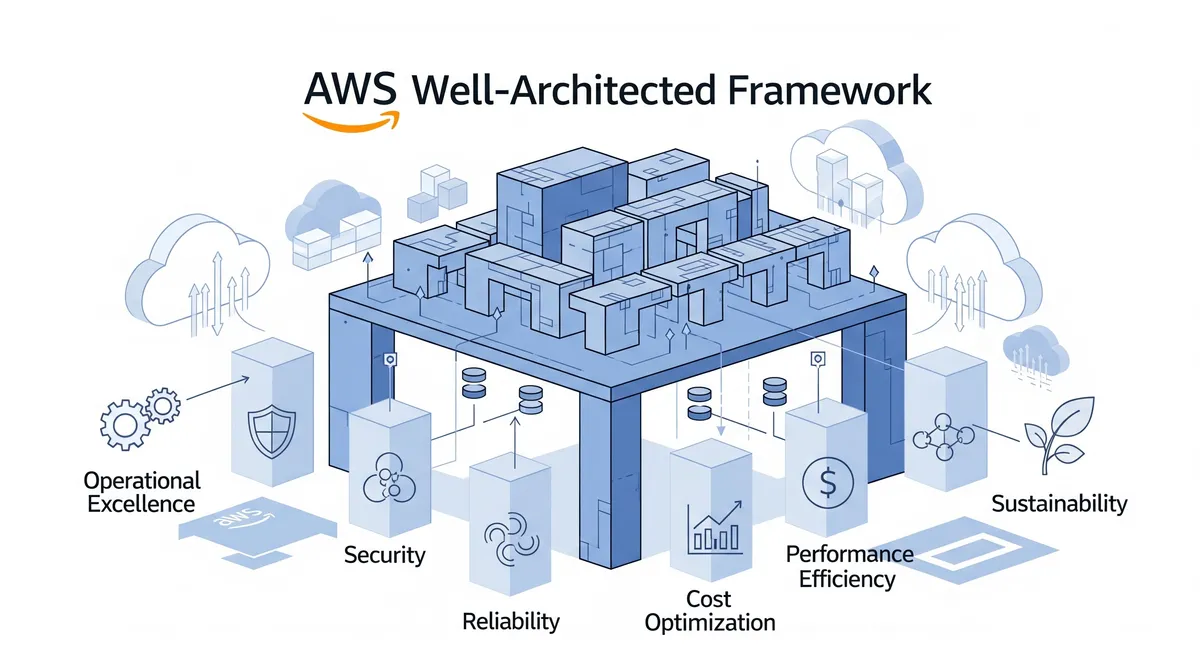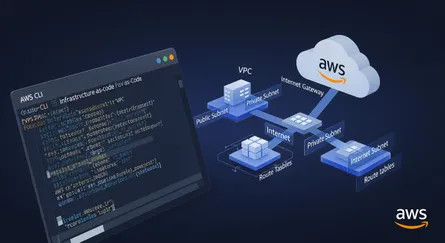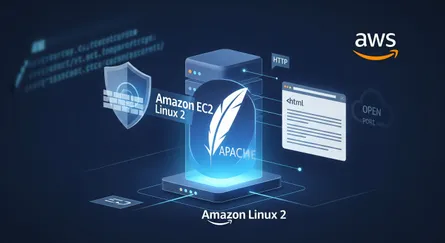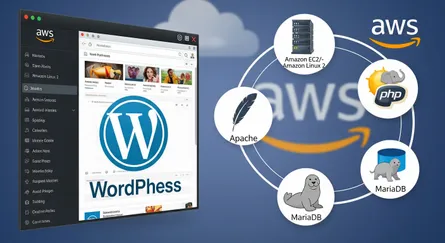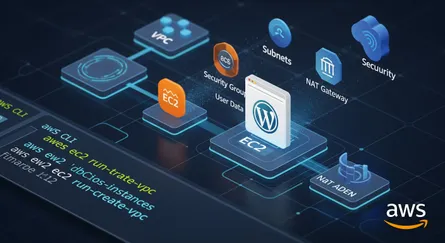TL;DR
AWS Well-Architected Framework is a collection of best practices for creating and running systems on AWS that are dependable, secure, effective, economical, and long-lasting. The framework is built around five pillars: operational excellence, security, reliability, performance efficiency, and cost optimization. A sixth pillar, sustainability, is also included and is dedicated to reducing the environmental effect of systems and advancing sustainable business practices. Organizations may optimize their cloud infrastructure, save costs, boost performance, and help create a more sustainable future by heeding the recommendations of the AWS Well-Architected Framework.
Introduction
Imagine that you have created a stunning new home that was meticulously designed and built to match your specific needs. Yet as time passes, you begin to see some foundation cracks, roof leaks, and other problems that lower the standard of your house as a whole. These difficulties are comparable to those that businesses using cloud computing services like AWS Web Services have (AWS). While there are numerous advantages to using AWS, businesses might encounter issues that compromise the dependability, security, and cost-effectiveness of their cloud infrastructure without careful planning and execution.
The AWS Well-Architected Framework enters the picture here. The framework offers a collection of best practices and principles for creating and managing efficient, effective, and reasonably priced systems in the AWS cloud. Organizations can make sure that their cloud infrastructure is tailored to their unique requirements and that they are getting the most out of utilizing AWS by adhering to the framework.
Let’s use the example of a business wanting to launch a new web application on AWS. They may make sure the application is created to be highly available, safe, and economical by utilizing the AWS Well-Architected framework. To make sure the application can cope with variable amounts of traffic without going offline, they can leverage AWS services like Elastic Load Balancing and Auto Scaling. Companies may also put security best practices into reality, such as employing AWS Identity and Access Management (IAM) to restrict access to resources and routinely evaluating their infrastructure for flaws.
Overall, the AWS Well-Architected framework is a useful tool for any business adopting AWS, assisting them in avoiding common errors and guaranteeing that their cloud architecture is tailored to their particular requirements.
Prerequisites
It’s crucial to comprehend the prerequisites necessary to use the AWS Well-Architected framework efficiently before delving in. Let’s look at a practical example to show how important these requirements are.
Consider a business that wishes to transfer its current IT infrastructure to AWS. They want to profit from the advantages of using the cloud, such as its greater scalability and flexibility, and they have heard about these advantages. They rapidly learn, though, that their present infrastructure was not created with the cloud in mind. Their staff is underprepared to use AWS services successfully, and they have outdated apps that don’t perform well in the cloud.
This emphasizes how crucial it is to set up specific prerequisites before attempting to use the AWS Well-Architected framework. These conditions include:
-
Knowledge of cloud computing: It’s critical to have a solid grasp of cloud computing principles and services, as well as the advantages and disadvantages of using the cloud. With instruction, certification, and practical experience with AWS services, one can acquire this expertise.
-
Business goals: It’s essential to understand the goals that the AWS infrastructure is designed to help you achieve. This involves choosing success measures and key performance indicators (KPIs).
-
Technical requirements: It’s crucial to determine the system’s technical requirements, such as scalability, security, and availability, before constructing an AWS architecture. This will make it more likely that the infrastructure will be created with the organization’s requirements in mind.
-
Plan for migration: Whenever moving current systems to AWS, it’s crucial to have a thorough plan outlining the procedure, including the services and tools that will be utilized, the sequence in which they will be migrated, and the anticipated timeframe.
Let’s take the scenario where a business wishes to move its current website to AWS. They must make sure they have the technical know-how to create a secure architecture that can handle the traffic on the website. Their business goals and KPIs, such as website uptime and response speed, must also be clearly understood. They must also have a migration strategy in place that involves moving their website to the cloud utilizing AWS services like AWS Server Migration Service.
Organizations may successfully design and build a cloud infrastructure that satisfies their goals and optimizes the advantages of utilizing AWS by making sure that these conditions are met before adopting the AWS Well-Architected framework.
What is the AWS Well-Architected Framework?
After discussing the requirements for successfully utilizing the AWS Well-Architected framework, let’s get into what the framework is.
For creating and running dependable, secure, effective, and reasonably priced systems on the AWS cloud, a set of best practices and principles known as the AWS Well-Architected framework is available. The methodology is meant to assist businesses in assessing current cloud infrastructures and pinpointing possible areas for development. Organizations may compare their design to industry best practices by using it as a standardized method of assessing cloud architectures across various sectors and use cases.
The AWS Well-Architected framework consists of six pillars:
-
Operational Excellence: Focuses on the ability to run and monitor systems to deliver business value and to continually improve supporting processes and procedures.
-
Security: Focuses on protecting information and systems. This includes identifying and mitigating potential security threats and vulnerabilities.
-
Reliability: Focuses on ensuring that systems operate correctly and consistently and that they can recover from failures.
-
Performance Efficiency: Focuses on using computing resources efficiently to meet system requirements and maintain performance as demand changes.
-
Cost Optimization: Focuses on avoiding unnecessary costs and maximizing the value of cloud investments.
-
Sustainability: This pillar focuses on designing systems that are environmentally sustainable and reduce the carbon footprint of IT infrastructure.
Consider a scenario in which a business has developed a new application on AWS that is having performance problems. The Performance Efficiency pillar of their design may be assessed using the AWS Well-Architected methodology. Companies may discover that they are not efficiently leveraging AWS services like AWS CloudFront or AWS Elastic Load Balancing, which causes their users’ response times to be delayed. They may enhance the application’s performance and give users a better experience by putting best practices from the Performance Efficiency pillar into effect, such as improving data transmission across AWS services.
The AWS Well-Architected architecture, in general, offers businesses a disciplined method for planning and managing their cloud infrastructure on AWS. Organizations may use the framework to make sure their systems are dependable, secure, effective, and economical, and that they are getting the most out of utilizing AWS.
Operational Excellence
Let’s discuss Operational Excellence, the first pillar of the AWS Well-Architected methodology, in more detail.
Operational Excellence is all about ensuring systems run effectively and efficiently, delivering business value while continually improving supporting processes and procedures. This involves developing and implementing standard operating procedures, monitoring systems, and establishing metrics to measure success.
For example, let’s say a company is running a website on AWS that is experiencing intermittent downtime, leading to frustrated users and lost revenue. Using the Operational Excellence pillar of the AWS Well-Architected framework, they can identify ways to improve their system uptime and minimize disruptions.
Using Amazon’s managed services, which may automate many of the chores related to running and monitoring systems, is one method for enhancing operational excellence on AWS. For instance, the business may set up alerts that alert them when their website is experiencing unavailability using Amazon CloudWatch, a managed service that offers monitoring and operational insights for AWS resources. They will be able to swiftly detect and fix problems before they affect users thanks to this.
In addition, the company can establish a continuous improvement process to ensure that its website remains stable and reliable over time. This may involve setting up regular reviews of system performance and making incremental improvements to optimize system efficiency and reduce downtime.
Overall, the Amazon Well-Architected framework’s Operational Excellence pillar offers a collection of best practices for creating and running dependable, scalable, and effective systems. Organizations may reduce downtime, enhance system performance, and provide value to their clients by using these practices.
Security
Security is the second pillar of the Amazon Well-Architected Framework. One of the most important components of any IT infrastructure is security, which is necessary to defend against online attacks and safeguard sensitive data, systems, and applications.
Let’s imagine that a business uses AWS to store and handle sensitive customer data, including financial or personal identification data. The business is responsible for making sure the data is safe and shielded from harmful activity and illegal access. The business is able to identify and put into effect best practices for protecting its data and systems by utilizing the Security pillar of the AWS Well-Architected Framework.
The Security pillar includes a set of best practices for securing AWS resources and applications, including:
-
Identity and Access Management (IAM): This pillar’s main goal is to guarantee that only authorized users may access AWS resources and that access is allowed in accordance with the least-privilege principle.
-
Detection and Response: This pillar concentrates on promptly identifying and counteracting security risks to lessen the effects of security events.
-
Infrastructure Protection: Implementing firewalls, intrusion detection systems, and encryption are only a few of the measures included in this pillar’s protection of infrastructure against internal and external threats.
-
Data Protection: Encryption, key management, data backup, and recovery are all aspects of this pillar’s protection of data both in transit and at rest.
To manage access to Amazon resources, the business may, for instance, utilize AWS Identity and Access Management (IAM). The danger of unwanted access or unintentional data disclosure is decreased since the business may utilize IAM to provide each person or application the bare minimal set of permissions required to carry out their job.
Overall, the Amazon Well-Architected Framework’s Security pillar offers a collection of best practices for protecting AWS resources and applications. Organizations may lower the risk of security lapses and safeguard sensitive data and systems from online attacks by putting these best practices into effect.
Reliability
Reliability is the third pillar of the AWS Well-Architected Framework. The main goal of reliability is to make sure that systems function normally with little disturbance or downtime. This is particularly crucial for mission-critical applications that have to be accessible nonstop and throughout the clock.
Let’s look at an example of an e-commerce business that uses AWS to power its website. The business must make sure that its website is responsive and constantly available, especially during busy times like the Christmas shopping season. The business is able to identify and put into practice best practices for guaranteeing high availability and uptime by using the Reliability pillar of the AWS Well-Architected Framework.
The Reliability Pillar includes a set of best practices for designing and operating resilient systems, including:
-
Foundations: This pillar focuses on establishing a solid foundation for systems, including the use of fault-tolerant hardware and software, redundancy, and automatic scaling.
-
Failure Management: This pillar focuses on managing failures when they occur, including planning for failures, monitoring for failures, and implementing automatic recovery procedures.
-
Change Management: This pillar focuses on managing changes to systems and applications, including testing, validating, and documenting changes before implementing them.
For example, the company may use AWS Elastic Load Balancing (ELB) and Amazon EC2 Auto Scaling to ensure that its website is always accessible, even during periods of high traffic. ELB intelligently distributes incoming traffic among many Amazon EC2 instances, avoiding any one instance from getting overburdened. The website can endure traffic surges without going offline because to Amazon EC2 Auto Scaling, which automatically adjusts the number of EC2 instances based on traffic demand.
In addition, the company can use AWS CloudFormation to automate the deployment of infrastructure and applications, ensuring that changes are tested and validated before being implemented. CloudFormation templates can be version-controlled and reviewed, providing a structured process for managing changes to systems and applications.
Overall, the Amazon Well-Architected Framework’s Reliability pillar offers a collection of best practices for creating and running highly available and resilient systems. Organizations may make sure that their systems function as planned with little interruption and downtime by putting these best practices into effect.
Performance Efficiency
The fourth pillar of the AWS Well-Architected framework is Performance Efficiency. This pillar focuses on using computing resources efficiently and effectively, to achieve desired outcomes and maximize the return on investment.
Let’s consider an example of a media company using AWS to host their streaming platform. The company needs to ensure that its platform can deliver high-quality video streaming to users, while also optimizing costs and minimizing resource waste. By using the Performance Efficiency pillar of the AWS Well-Architected framework, the company can identify and implement best practices for achieving these goals.
The Performance Efficiency pillar includes a set of best practices for designing and operating high-performance systems, including:
-
Selection: This pillar focuses on selecting the right computing, storage, and database services to meet the specific needs of the workload, based on performance, cost, and other factors.
-
Review: This pillar focuses on reviewing systems regularly to ensure that they are using resources efficiently, and identifying opportunities for optimization.
-
Monitoring: This pillar focuses on monitoring systems to identify performance issues and bottlenecks, and using data to inform optimization decisions.
For example, the media organization can utilize Amazon CloudFront and Amazon S3 to enhance the transmission of its video content. A content delivery network (CDN) called CloudFront delivers material globally to enhance performance and lower latency. S3 is a highly scalable and reliable storage service that can store and retrieve any volume of data from any location on the internet.
By using CloudFront, the media company can deliver their video content from edge locations that are closer to the end-users, reducing latency and improving performance. They can also use CloudFront to cache frequently accessed content, reducing the load on their origin servers and optimizing costs. By using S3, the company can store and retrieve its video content reliably and cost-effectively, with high durability and availability.
Also, the business may utilize Amazon CloudWatch to keep tabs on the efficiency of its systems and spot areas for improvement. Amazon resources are monitored and recorded in real-time by CloudWatch, which may also be used to create alarms and start automatic processes depending on performance data.
Overall, the AWS Well-Architected framework’s Performance Efficiency pillar offers a collection of best practices for creating and running systems that are effective, efficient, and cost-efficient. Organizations may accomplish their targeted results while optimizing return on investment by putting these best practices into effect.
Cost Optimization
Certainly! Let’s discuss the Cost Optimization pillar of the AWS Well-Architected framework.
Imagine a company that is running a large-scale application on AWS. The company is experiencing unexpectedly high costs, and they’re struggling to identify ways to optimize its spending. By using the Cost Optimization pillar of the AWS Well-Architected framework, they can identify areas where they can reduce costs while still meeting their performance and scalability requirements.
The Cost Optimization pillar includes a set of best practices for optimizing costs and maximizing the value of your AWS infrastructure, including:
-
Cost-Aware Architecture: This pillar focuses on designing and deploying systems that are cost-efficient and scalable, using services that are optimized for cost-effectiveness.
-
Cost-Effective Resources: This pillar focuses on using the most cost-effective AWS resources for your application, such as using reserved instances instead of on-demand instances.
-
Matching Supply and Demand: This pillar focuses on optimizing resource allocation and usage to match demand, using tools like Auto Scaling to automatically adjust resources based on usage.
-
Optimizing Over Time: This pillar focuses on continuously reviewing and optimizing your AWS infrastructure over time, using tools like AWS Cost Explorer to identify cost-saving opportunities.
For example, suppose the business runs its application on Amazon EC2 instances. With AWS’s Spot Instances, which enable them to bid on unutilized EC2 capacity at a cheaper price than on-demand instances, they may reduce expenditures. This can provide the requisite performance and scalability at a substantial cost savings.
Also, the business may utilize Amazon Cost Explorer to examine its consumption and find areas where costs might be reduced. To cut expenses, businesses could decide to terminate or downsize instances that are operating at low usage rates, for instance.
Overall, the AWS Well-Architected framework’s Cost Optimization pillar offers a collection of best practices for cutting expenses and enhancing the use of your AWS infrastructure. Organizations may cut expenses while still achieving their performance and scalability goals by implementing these techniques.
Sustainability
Certainly, let’s talk about the Sustainability pillar of the AWS Well-Architected framework. This pillar focuses on designing and operating systems that minimize their environmental impact and promote sustainable business practices.
For example, the business may employ AWS’s services to increase the web application’s energy efficiency. Using AWS’s Auto Scaling function, which automatically modifies the number of instances operating in response to variations in demand, might be one strategy. The firm may avoid running surplus infrastructure by dynamically altering its capacity, which lowers energy use and emissions.
Additionally, the company can use AWS’s Carbon Footprint tool to measure and report its environmental impact. This tool calculates the carbon emissions associated with running AWS resources, allowing the company to identify areas for improvement and track progress over time.
Overall, the AWS Well-Architected framework’s Sustainability pillar offers a set of best practices for developing and running systems that support sustainable business operations. Organizations may reduce their environmental effect and help to create a more sustainable future by putting these ideas into practice.
Applying the AWS Well-Architected Framework
Consider a business that wants to move its IT infrastructure to Amazon to benefit from the scalability, flexibility, and affordability of the cloud. They are worried about how to construct its architecture, though, to make sure it is dependable, secure, economical, and long-lasting.
The business may utilize the Amazon Well-Architected Framework, a set of best practices and principles for developing and running dependable, effective, and secure cloud-based systems, to allay these worries. The operational excellence, security, reliability, performance effectiveness, and cost optimization pillars make up the Amazon Well-Architected Framework.
To apply the AWS Well-Architected Framework, the company can work with AWS experts or partners to conduct a Well-Architected Review, which is a process of evaluating the current state of their architecture against the five pillars of the framework. This review can help identify areas of improvement, prioritize actions, and provide recommendations for optimizing the architecture to better align with AWS best practices.
For example, let’s say the company undergoes a Well-Architected Review and identifies that its infrastructure is not cost-optimized and that they are spending more than necessary on its cloud resources. The AWS expert conducting the review may suggest implementing AWS services such as AWS Cost Explorer, which provides visibility into the company’s AWS spending and enables them to analyze and optimize their costs.
In addition, by implementing the Amazon Well-Architected Framework, the business may lessen the chance of downtime and security breaches by identifying possible issues before they become problems. The organization may enhance the overall health and performance of its infrastructure by putting the best practices recommended in the framework into practice, which will lower the chance of problems that could have an adverse effect on its clients and business operations.
After the Well-Architected Review, the company can prioritize the recommended actions and start implementing the changes necessary to optimize its infrastructure. The company can continue to use the AWS Well-Architected Framework as a guide to maintain the health and performance of its infrastructure over time, adapting to changes in business needs and technological advancements.
Overall, implementing the Amazon Well-Architected Framework offers a systematic and thorough approach to developing and running cloud infrastructure that satisfies business goals, is compliant with AWS best practices, and enhances efficiency, security, dependability, and cost-effectiveness.
Conclusion
In conclusion, the Amazon Well-Architected Framework is a set of best practices created to aid businesses in developing and managing dependable, secure, productive, and affordable systems on AWS. By utilizing the framework, businesses may steer clear of typical mistakes, cut expenses, and improve the performance and dependability of their systems. The framework offers a structured method for developing and assessing systems, spotting possible problems, and putting corrective measures in place.
References
- AWS Well-Architected Framework - Main Page
- AWS Well-Architected Framework Whitepaper (PDF)
- Operational Excellence Pillar Whitepaper
- Security Pillar Whitepaper
- Reliability Pillar Whitepaper
- Performance Efficiency Pillar Whitepaper
- Cost Optimization Pillar Whitepaper
- Sustainability Pillar Whitepaper
- AWS Well-Architected Tool
- AWS Well-Architected Labs
- AWS Cloud Adoption Framework (CAF) (Related framework for cloud adoption)
- AWS Architecture Center (Provides reference architectures and guidance)
- AWS Cost Explorer
- AWS Identity and Access Management (IAM)
- Amazon CloudWatch
